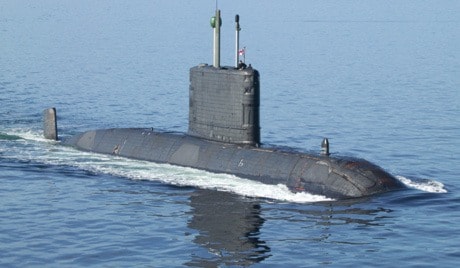Blink and you may very well miss Cmdr. Christopher Ellis’s quick-as-lightning descent down more than a dozen ladder rungs.
“You get used to it,” he says, appearing all of a sudden, it seems, deep inside the submarine he commands at CFB Esquimalt, where the sun’s rays are replaced by artificial lighting and the only view outside is through two periscopes.
The submarine captain’s every movement is economy in motion, exuding precision and control – important qualities for submariners to have when working at depths known only to marine life, and 400 other submarines possibly lurking in the deep blue.
Inside HMCS Victoria the control room resembles a construction site rather than a scene out of the Sean Connery submarine flick, The Hunt for Red October.
But it could, complete with the red lights.
“It might not be as tense as that,” Ellis, 42, says with a laugh. “But it can always get tense at sea, yes.”
He weaves his way through the sub’s nerve centre where wires and tubing, plastic sheets and tools will soon become a memory after an intensive five-year overhaul – a sign the tide is about to change for the Victoria.
For the past five years – half of her life as a Canadian submarine – the vessel has been in dry dock. But this month marks her highly anticipated return to salt water.
“It’s very exciting, 2011 is a huge year,” says Ellis, a 24-year military veteran who first joined the Victoria in 2004 and then took command in 2009.
“We’ll be sailing. It will be the first fully operational weapons-capable Victoria-class submarine on the West Coast.”
The plan is to have her tugged out of dry dock at CFB Esquimalt and berthed at a base jetty in late February for further testing.
Her black fin – with Ellis at the top – will likely be spotted in early July cutting through the water past Fisgard Lighthouse, out to the Strait of Juan de Fuca. The vessel will undergo about six more months of tests and trials before it achieves full operational status, possibly in December.
“We’re almost there,” says Ellis, a Victoria resident and one of only two active Canadian submarine captains. “You’ve got to make sure everything is correctly made.
“A sub is not going to go until it’s good to go. There are quite a lot of checks and balances we need to do.”
Inside the submarine, Ellis nimbly steps around one of his 20 submariners working jointly with base fleet maintenance facility workers at CFB Esquimalt.
The diesel-electric long-range patrol submarine has been as dry as it has been wet since the Canadian navy commissioned it in 2000, after acquiring four Victoria-class subs from the United Kingdom, which was downsizing its own sub program due to post-Cold War cutbacks.
HMCS Victoria arrived in her namesake city in 2003, becoming the first submarine permanently stationed on the West Coast since 1974. It ran training exercises and weapons system tests in the Strait of Juan de Fuca before it was taken out of the water in 2005.
In the past five years she’s undergone extensive maintenance to ensure her engineering systems are technically fit, and to prepare her weapons system for the possible armament of up to 18 Mark 48 torpedoes – some of the most powerful weapons in the Canadian military’s arsenal.
Given their might, the torpedoes would be stored in one of the larger spaces on the sub in which space is at a premium.
The galley, the head and sleeping bunks are all designed to maximize space – even the doors slide instead of swing open.
For the same reason there’s a small crew of between 48 and 59 submariners, all trained in multiple roles.
“We demand a lot more from our sailors because of that,” Ellis says.
A cohesive crew is essential in such a confined work space for long durations. The battery-equipped vessel can stay submerged for about 40 days before needing to resurface for fuel and supplies.
“The last thing you want to do is run out of coffee,” the commander quips.
Along with its torpedo capabilities and endurance, stealth is also the Victoria’s weapon at home and abroad to perhaps spot a darkened warship at night, monitor polluters or illegal fishing activities, drug running and piracy.
“Trying to find the submarine is like finding a needle in the haystack,” Ellis explains. ”We pack a lot of bang for the buck. You never know if the sub is there watching you.”
His command of HMCS Victoria will be the last time he serves on a submarine before taking on a headquarters submarine staff position in Ottawa or at CFB Esquimalt in July 2012.
The submarine captain moves lithely up the vessel’s ladder and steps into the daylight.
“The light is on at the end of the tunnel,” Ellis smiles, stopping to survey the exterior of the immense black vessel.
“The reward is being part of this crew as we finally get the sub back to sea.”
emccracken@vicnews.com
Did you know
HMCS Victoria is a long-range diesel-electric patrol submarine
Motto: “Expect no warning”
Crew: At least 48, maximum of 59, includes two women
Patrol endurance: about eight weeks
Length: 70 metres – just longer than a hockey rink
Diving depth: More than 200 metres
Speed: 20 knots submerged; 12 knots surfaced
Living quarters: about 47 metres long
Torpedoes: 18 Mark 48s including 12 on the rack and six ready for firing
Exterior: Covered in anechoic tiles, which inhibit noise and absorb sonar for added stealth
